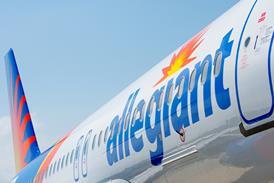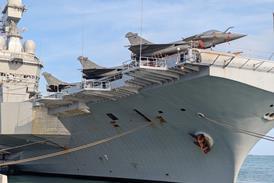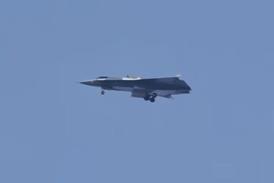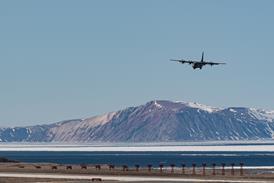
Peter Henley/PHOENIX
Re-engineing the Dassault Falcon 20 with AlliedSignal TFE731-5BR-3C turbofans is an interesting and unusual project. It is not the first instance of an ageing, but sound, airframe being given a new lease of life with a later-generation engine - but it is unusual in that the resultant aircraft does not look dated; that the project has the full approval and cooperation of the original manufacturer; and that the retrofit scheme is undertaken as a service bulletin and not as derivative or supplementary type modification.
Furthermore, the re-engineing programme has been a long-term commercial success (100 retrofitted Falcon 20s have now been delivered) and gives customers an attractive, competent corporate jet for about $8-9 million.
All these were compelling reasons for Flight International to become re-acquainted with the programme and to flight test an example of the latest AlliedSignal-powered version.
The original Falcon 20 was derived from the Dassault Mystere fighter, using the wing and tail to produce a nine-seat business jet. The resultant airframe was extremely strong, with classically clean lines and notably pleasant flying qualities. The Falcon 20 entered service in 1965 and some 486 were built. The less successful aspects of the original General Electric CF700-powered aircraft were its lack of range - less than 3,700km (2,000nm) - high fuel consumption and high environmental noise. With the passage of time, the appeal of the airframe endured while the shortcomings of its powerplants became more and more obvious.
ENGINE UPDATE
AlliedSignal (then Garrett Turbine Engine) had successfully re-engined Lockheed Jetstars and Hawker 125s when the company turned its attention, in the mid-1980s, to the Falcon 20 as another possible candidate aircraft. It found many examples still in the hands of their original operators - most of which were attracted to a proposal to update their reliable, but dated, workhorses. For new customers, AlliedSignal discovered Falcon 20s that could be bought for $1-2 million, dependent on condition. Almost without exception, they were structurally excellent and free of corrosion.
The CF700s, which had thrust ratings between 4,000lb (18kN) and 4,500lb depending on mark, were replaced with AlliedSignal TFE731-5ARs of 4,500lb thrust. In 1991, the -5BR was substituted, increasing thrust to 4,750lb and incorporating many detailed improvements. The -5BR was the engine chosen by Dassault for the Falcon 900B, which meant that the identical power unit, including nacelles and thrust reversers, could be used on the Falcon 20B with only minor changes to the pylons to match them to the different curve of the rear fuselage of the Falcon 20.
The conversions can be carried out either by Dassault Falcon Services in France, Transairco in Geneva or Garrett Aviation Services in Springfield, Illinois, all of which are subcontractors to AlliedSignal. Dassault remains the design authority and readily accepts that the AlliedSignal-powered Falcon 20 makes an excellent "entry-level" aircraft to complement its current range of larger Falcon business jets.

The amount of work done during conversion is largely determined by customers. A corrosion inspection is mandatory and the -5BR powerplant comes with digital electronic engine control (DEEC), so even the basic conversion involves extensive dismantling of the aircraft.
Most customers, says Don Sterling, marketing and sales manager, take the opportunity to incorporate more updates, including Rockwell Collins Pro Line 4 avionics, with electronic flight instrument system (EFIS) and autopilot. The cabin can be refurbished if required.
Typical costs for the work are $3.6 million for retrofitting the powerplants and incorporating DEEC, plus $350,000 for the optional Dee Howard thrust reversers. A new AlliedSignal 36-150 auxiliary power unit (APU) costs $300,000 and exterior painting about $47,000.
The Falcon 20B flown by Flight International was made available at the AlliedSignal facility at Sky Harbor International Airport in Phoenix, Arizona, by its owner, Berk Holding, which had recently had the conversion completed. This had been a fuller update including the Pro Line 4 EFIS and autopilot.
The first impression gained from seeing the aircraft parked on the ramp was its ageless elegance. Finished in white overall with little decoration, the purity of line of the original French design was apparent. The only discord came from the large wing fences which, it has now been established, serve no beneficial purpose but are too expensive to remove because of the re-certification flying that would be required.
The cabin door is on the forward left side of the fuselage and opens downwards to form steps. The cabin was light and attractively furnished. The cockpit is small because of the overall small size of the fuselage, and contains the first visual clue that the Falcon 20B is not of the latest business jet generation. Instead of the now familiar clean, crisp look of the modern cockpit with five or six cathode ray tube displays and push button indicator switches, there are analogue instruments and tumbler switches amid the four Pro Line 4 display tubes.
Thought has clearly been given to fitting everything in, and the result is a business-like cockpit which is reasonably easy to find one's way around - but it does look "busy" compared with a state-of-the-art cockpit. Despite the obvious attention to detail, room could not be found for everything on the main instrument panel and the thrust reverser indicators are mounted on top of the glareshield, while the parking brake handle emerges from the glareshield (and thus does not come easily to hand) and includes a slightly complicated latch to select standby brakes. There is a large centre console which effectively fills the space between the seats. Gaining or leaving the seats involved stepping over the seat cushion and bending one's head below the overhead panel.
ADJUSTABLE CONTROLS
The seats have four-point harnesses, and are adjustable fore and aft, and for height and recline; there are fold-away armrests which are not adjustable for height. The rudder pedals are adjustable for reach via a lever between the pilot's knees, beneath the instrument panel. The field of view is good, each pilot being easily able to see his wing tip; a sunscreen on a sliding rail above the windscreens and an openable direct-vision window are provided for each pilot.
The APU would normally be used for air-conditioning on the ground and for engine start. This particular aircraft, however, had not had be upgraded with the optional AlliedSignal 36-150 and its existing APU was in any case unserviceable. Once the engines were started, they provided limited cockpit and cabin cooling on the ground but, at higher powers when airborne, provided pleasant conditioning.

The engines were started using ground power in the absence of an APU. This process began at the overhead panel by using a switch to select the engine to be started and pressing the starter button. The relevant power lever was then unlatched to introduce fuel and the relevant engine gauges monitored until a stable ground idle was reached. Manual shut down would be needed if a malfunction occurred.
The EFIS was switched off for starting, but I was assured this would not be necessary for an APU-powered engine start. The engine instruments are arranged in two vertical columns to the left of the centre instrument panel; each engine had indications of N1, ITT, N2, fuel flow and oil temperature and pressure. There is one nosewheel steering control on the captain's side panel and taxiing was straightforward, although the toe-operated wheel brakes were fierce.
Sky Harbor is 1,200ft (365m) above sea level; the weather was hot and dry with a light westerly surface wind; and runway 26 Left was used for take off. Take-off reference speeds and engine N1 were extracted from the flight manual for our all-up weight and ambient temperature. Our aircraft (registered N104SB) with about 2,720kg (6,000lb) of fuel and with a crew of three, weighed 12,260kg at take off. At the outside air temperature of 33°C, the reference speeds were: V1 116kt (215km/h), V2/VR 120kt and VF (flap retraction) 150kt with 10° flap and leading edge slats selected. (The Falcon 20B has flap settings of 10°, 25° and 40°- all with leading edge droop.) AlliedSignal senior pilot Steve Crowe was in command and Stjepan Bau, Berk Holding's chief pilot, was safety pilot.
For take-off, the engine power levers were moved to the forward limit of the quadrant. The -5BR engines spooled up rapidly. Crowe checked that they achieved the predicted N1, after which the aircraft accelerated rapidly.
The departure procedure and climb to cruising level were flown using the autopilot. Climb power was selected at flap retraction and thereafter engine power was maintained, as set, by the DEEC. A switch behind the power lever quadrant selects the engine synchroniser on or off. The autopilot flew the departure tracks and climb smoothly and accurately. Two steps were built in by air traffic control introducing brief pauses at 24,000ft and 32,000ft. The complete climb to 41,000ft took 27min and 530kg of fuel were used. At 41,000ft a brief cruise was established; the speed stabilised at M0.78 and the fuel flow at 590kg an hour.
The EFIS presentation includes an attitude and direction indicator (ADI) with vee-bars and a horizontal situation indicator (HSI). Airspeed is shown as a digital strip on the left side of the ADI, with limiting airspeeds highlighted in red. Instantaneous airspeed or Mach number is shown beside the strip calibration. Vertical speed is not shown by the EFIS and had to be found by extending the instrument scan to include the traffic alert and collision avoidance system (TCAS) analogue presentation to the right of the captain's EFIS displays. This shows the rate of climb and descent. Altitude is shown digitally to the right of the ADI and cleared altitudes can be selected on a small panel midway between the pilots, beneath the coaming.
An instrument departure had been entered via the flight management system (FMS) control panel before take off and the tracks and waypoints were clearly displayed on the HSI. There is no vertical navigation capability. The small FMS display screen on the centre console, however, can be used to display engine fuel consumption and flight plan information.
The autopilot was dispensed with and, leaving cruise power set, two 45° banked turns were flown. At about 2g, buffet could be provoked but it was a strong, natural, dynamic stall warning that would be difficult to ignore, and relaxing back pressure on the control column eliminated the buffet. Acceleration to M0.86 did not produce Mach buffet, indicating that the aircraft is at home at its highest operating levels.
A descent was then started and, with the power levers at flight idle and airbrakes out, a rate of descent of 6,000ft/min (30.5m/s) was seen at M0.7. The airbrakes are selected by a lever on the centre console and can be only in or out. Selecting them out caused a noticeable burble, but almost no discernible pitch change. Selecting them in caused a roll to the right which stopped at about 25° of bank. This characteristic was repeatable and was presumably caused by asymmetric travel of the airbrakes.
CONTROL HARMONY
Once in a block of airspace between 16,000ft and 18,000ft, the Falcon was manoeuvred at speeds between 200kt and 250kt. The controls were nicely harmonised with moderate forces in all three axes; roll acceleration and rate of roll were good for this class and size of aeroplane.
The Falcon has no artificial stall protection (ie, neither a stick shaker nor a stick pusher), yet its horizontal stabiliser is midway up the fin. It does not require a yaw damper (the autopilot includes a yaw damper, but the aeroplane may be despatched without a serviceable autopilot).
With the aircraft trimmed hands-off at 200kt with the yaw damper in, a rudder pedal input (a doublet) provoked a Dutch roll which was damped in about two cycles; with the yaw damper out, damping took about four cycles. A clean stall (trimmed at 130kt), approached at 1kt/s deceleration, resulted in buffet at 115kt and a g-break at 110kt. Aileron effectiveness was good into the stall; indeed there was a leisurely roll to the left at the stall which could be countered equally effectively with rudder or aileron - or a combination of both - without adverse affect. The characteristics were the same for the stall with undercarriage down and full flap (trimmed at 105kt, buffet at 90kt, g-break at 84kt), with the same roll to the left again easily countered. Once again, there may have been a peculiarity with this airframe causing the roll.
Further evidence of the soundness of the original design came with the extension of flap and undercarriage just below the relative limiting speeds. There was only the merest pitch change with flap (and no ballooning) and none with the undercarriage. The Falcon was then flown manually to a local airbase for a touch and go landing. At rotation, after the roller landing, Crowe throttled back to simulate a failure at V2 and, again, the aircraft was easy and pleasant to fly.
The Falcon 20B is an appealing aircraft to a pilot because of its endearing handling qualities. It also appeals to its owner through its modest cost. Once the retrofit is completed the airframe has no specified limit to its life and no further routine corrosion inspection is required for 24 years or 20,000 flying hours.
The Falcon 20B can use a balanced field of 5,000ft at maximum take-off weight (sea level, ISA conditions) and can cruise at up to M0.83 up to a maximum certified level of 42,000ft. The maximum take-off weight is 13,160kg and the full fuel payload 830kg.
How can such an attractive package be marketed for under $10 million? The answer lies in the airframe; it is structurally strong and aerodynamically sound and, hitherto, available cheaply (compared to the cost of a newly built airframe). The corollary is, of course, that there is not a limitless source of Falcon 20s.
The only penalty I could discern during my brief encounter was the cockpit, which is not at the cutting edge of technology. Systems management is not automated (and there will always be some pilots who prefer manual systems operation), and there is a distinct mix of the old and new - for example the mechanical lever which selects the standby hydraulic system electric pump coexisting with the Collins EFIS.
This seems a small penalty. The Falcon 20B is strikingly elegant, comfortable, quiet, fuel efficient and, apparently, ageless. Overall it seems to offer excellent value for money.
Source: Flight International























